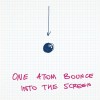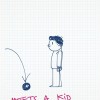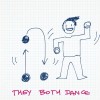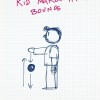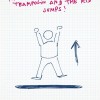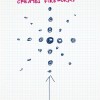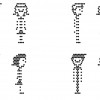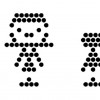Working with animation studio Punga,1stAveMachine’s Nico Casavecchia had the honor of creating the world’s first movie at the scale of individual atoms — the world’s smallest movie — at least until someone figures out how to animate quarks.
Nico took some time to share details about the unique process behind this project.
How did this job come about?
The job came to 1stAvenueMachine in November of 2012, and we started having the initial meetings with Ogilvy & Mather around then.
Was there a script or did you have to propose a story?
We worked on the script for a long time. We had different ideas on how to approach it. Originally, it was related with an actual scientific achievement, which is connected to the use of nanotechnology for data storage, so we were working with a lot of concepts around the idea of human memories, information, things like that.

I was obsessed with the plaque designed by Carl Sagan for the Pioneer probe sent to Jupiter. I thought, “If we’re writing a message with atoms, it has to be transcendent and celebrate human achievements.” It was a lot of pressure!
I started thinking about animating a famous haiku, the smallest poetic form, or illustrating a quote of Carl Sagan on how atoms are the building blocks of life.
Fortunately, the guys at the agency brought me back to reality and suggested to have fun with it. They came up with this little story, which is human and universal. They wanted something that didn’t need words — which now seems like the right decision. Once we had the script, I started fleshing out the way to tell the story in the most economic format possible.
I’m assuming there were a lot of technical limitations for this project. Did you have to learn a lot about molecular imaging in order to even begin thinking about this project?
This was by far the most interesting commission in my career. Everyday we found a new, beautiful challenge.
Before even starting to define the limitations of the project, we had to establish a common language between the scientists and all the other teams. It took us a lot of work to be on the same page.
So many things that — to the IBM team — seemed obvious, were absolutely cryptic for us. We had to invent new baby words that we could understand and work with. “Spring coupling impact of the neighboring atoms on magnetic screening” became “the whole created by the bumps.”
Slowly, the boundaries of the project started to emerge. In the beginning of the process, we were told that they could move 200 atoms. If you think about atoms as pixels on a screen that means that you can only move 200 pixels in your animation.

A single space invader sprite has 52 pixels. 200 operations would move that sprite 4 times in the screen and that would be it, only 4 frames. It was very limiting.
Andreas Heinrich and his team of scientists revised the process and came up with a new number. They figured that if their whole team took turns and animated in shifts they could move 5000 atoms within the time frame we had. That changed everything. 5000 operations is enough for an economic animation.
Until that point my designs were pixel designs, most like a Tamagochi or a vintage video game. Black and white pixel art.
After a lot of meetings and presentations, we finally realized that the Scanning Tunneling Microscope arranged atoms in an hexagonal pattern. This changed all our designs and made it complicated to get compelling images. I was bummed out by this for a while, but in the end it turned out to be a good thing. Images in an hexagonal pattern, much like graphic design systems from the 60s, are highly iconic.
The guys at studio Punga in Buenos Aires did a great job translating the character to the new grid, and I feel it’s more memorable now than what it was in orthogonal pixels. I knew Punga was the right studio for the job, their character design work is among the most sophisticated in the world. They can achieve highly expressive characters with maximum economy, exactly what we needed.
Did you work directly with IBM? If so, what was that process like?
Yes. During the process, I constantly felt like a monkey trying to solve a math equation, but a very happy monkey.
Every day, we thought we had things figured out and every day we had to revise the process. Even to complete such an economic animation was a huge challenge.
I think it´s in 1stAvenueMachine´s DNA to deal with highly unusual scenarios, so nobody seemed to be surprised if we had to start over from scratch. It was the first time in my career that an agency, a production company and a special client admitted that failure is totally an option. I think we all took the assignment as an experiment that could go wrong. We often reminded one another that we were exploring a totally new territory with the technique.

We had a lot of conference calls trying to define the limits of the animation and to find common ground, but things came together when we met in the lab in Almaden, California. I think I got the exact picture of how cool the project was and finally understood the technical process behind it.
And I got to actually move atoms, which was pretty cool.
I have been constantly amazed by the patience of Andreas and his team in explaining everything to us. They are trained to speak to non-scientists, but working with them on a project is a different thing.
How did you actually manipulate the atoms?
We created an animatic that is exactly the piece but with black dots. Then we discovered that it had to be translated to a text format describing the position of every atom with a special set of coordinates. We tried to do it by hand, but the human error was constant. Plus, it was exhausting.
We ended up writing software that optically analyzed the animatic and wrote the lists of positions for the STM computer. Once the scientists had these lists of positions they could have an on-screen reference of where to move the atoms.
The technology in the IBM lab mixes super computers with vintage technology. The actual Scanning Tunneling Microscope computer system was created in the 90s, so they use an old PC from that era to move the atoms. I’m talking about floppy disks and 8-bit speaker.

They first scan the surface to get a picture of the atoms and then move the atoms one by one with the mouse to the right position very gently. Pretty much like animating peas with your elbows. It’s a really slow process.
I was concerned for the mental stamina of the scientists. I know animators have a particular mindset that allows them to endure, but they never did something like that.
The microscope is highly unstable and all sorts of things could get in the way, like undesired hydrogen atoms that snuck in the surface, so they were never 100% confident that they could actually finish. But they luckily did, due to an enormous effort by their team.
The resulting image is a 3D surface of the CO molecules over the copper crystal. We just put one frame after another and repeated some frames when we needed to hold. We didn’t add any comp to the movie.
What other aspects of the process were interesting to you?
Every day was interesting and a huge learning process.
Going to see the IBM lab and meeting the team was the best. They are such sweet people, not only highly intelligent but very curious.
These people, very much like artists, love exploration and challenges. IBM lets them research without immediate commercial goals, the kind of research on basic science that pushes innovation forward. It was great to be part of the team and to collaborate with them.
It’s funny that in our job you have to relearn the process on every assignment. Pretty much nothing you know will help you in a mixed media project like this.
I’m lucky to be part of 1stAveMachine because they love to pioneer completely uncharted territory and this was the perfect framework for the project.





